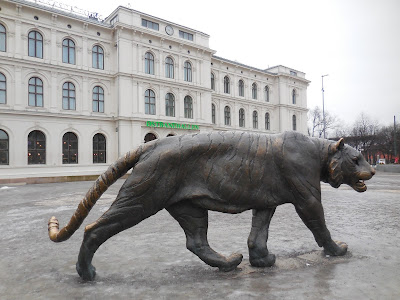As already mentioned, this tour takes place at 10 a.m. everyday. However, my friend and me thought it would be good idea to do this tour at the beginning of her stay in Oslo. It just turned out to be the coldest day ever since I arrived here - which might be the reason why none of my fellow students wanted to join for the tour. :D Anyway, we did the tour and survived, although it was cold and slippery which caused the tour to be even longer than usual, I guess.
I'll try and tell you as much about Oslo as I remember in the following. (I tried taking notes on my phone and taking photos with my camera simultaneously, but since you have to take your gloves off for both activities, my documentation is somewhat incomplete...)
The tour started at The Tiger, which is a tiger statue at Oslo central station.
 |
| It's actually huge! |
Background info: Oslo's nickname is Tigerstaden, i.e. The Tiger City. The name goes back to Bjørnstjerne Bjørnson, who called Oslo like this in a poem, basically saying Oslo is dangerous.
From The Tiger, we made our slippery way to Operahuset.
 |
| It's supposed to be a glacier, and the people on it represent penguins. :D |
The view of the Oslofjord you have next to / behind the opera actually inspired Edvard Munch to his nowadays best known work, Skrik - The Scream. When the sky turned red (at sunset, I assume), he heard "the scream of nature" there.
Bonus info: the business area around the opera, with PwC and the like, is called Barcode Area. That's because the buildings alternate in being tall and short. There's currently construction works going on, so there was no point in taking a photo.
Then we went to the "new" city centre. The old one had burnt down in fires, so the Danish king Christian IV decided to start a new city in an area that's today called Kvadraturen. Like this:
 |
| Pointer: "The new city will be HERE!" |
The orange thing in the background is the old town hall. Today, it it a restaurant. According to our tour guide, "everything turns into restaurants in Oslo!" Not sure why though, as eating out is not exactly cheap in Norway...
Speaking of colours: there's a code to the colours of buildings in Oslo - or at least, there was in former times. Red was cheap, yellow was medium, and white was expensive. So the fact that the palace (for photos, go to my first city exploration) is yellow instead of white is actually a political statement!
After briefly talking about Akershus Festning (fortress), we made our unsteady way to Rådhuset, Oslo's city hall.
Once inside to get warm again, our tour guide told us about this quite impressive building. She called it church-like, which is quite accurate, and explained that it's partly about worshipping the government (religion/church is not so much of a thing in Norway).
After briefly talking about Akershus Festning (fortress), we made our unsteady way to Rådhuset, Oslo's city hall.
 |
| It was seriously too cold to take another (better) photo. |
There's also a lot of wall-painting upstairs (we actually came back for this the other day, because the upper floor was closed on Monday due to some event):
However, what made the city hall most church-like was probably the instrument!
No, they don't have a regular organ there like churches - they have something like a bell organ! I looked it up, and it's actually called carillon. The carillonist of the city hall plays a melody every full hour. They even have a schedule online, so you can choose which melody you like most and go to Rådhuset accordingly!
The current schedule:
Anyway, we had to leave the warm city hall again at some point to cover Nationaltheatret (the National Theatre) ...
... the Grand Hotel from 1874, when nobody believed a hotel at this place could be a success ...
 |
| (Michael Jackson, Madonna and a bunch of other stars have stayed here.) |
 |
| (The high number of windows stands for transparency in politics.) |









No comments:
Post a Comment